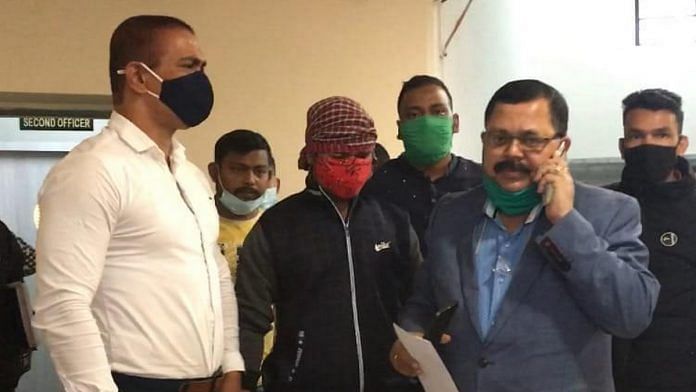Kolkata: On 25 and 27 February, two suspected militants belonging to the Kamtapur Liberation Organisation (KLO) were nabbed from Siliguri in a joint operation led by the West Bengal Special Task Force (STF). The arrests — of Abinash Roy, who hails from Assam’s Kokrajhar district, and Mrinal Barman who comes from Siliguri — have raised worries about the re-emergence of the KLO, a banned outfit that has been lying low for more than a decade.
The KLO was formed in December 1995 by a section of the Koch-Rajbongshi community to carve out a separate Kamtapur state, comprising of West Bengal’s North & South Dinajpur, Cooch Behar, Malda, Darjeeling, Jalpaiguri districts, as well as Assam’s Kokrajhar, Dhubri, Goalpara and Bongaigaon.
Though it began as an organisation to seek reprieve from large-scale unemployment, economic backwardness, and other social issues, the KLO soon converted into an armed movement. According to police sources, KLO chief Jibon Singha is currently hiding along the borders of Nagaland and Myanmar.
In the recent arrests, primary investigations found that the duo was planning to procure arms from Bihar and send them to Myanmar. While Roy had allegedly received training from Myanmar, Barman was untrained. Both were staying separately, but were in touch for over a year. It was the arrest of Roy that led the police to Barman.
ThePrint spoke to multiple sources in the police to understand how the banned outfit continues to keep its organisation alive.
Also read: One arrested, two detained after councillors of TMC, Cong shot dead in Bengal
Modus operandi
In the last five years, there hasn’t been a single instance of violence in West Bengal that had a KLO link. The police say the organisation’s supporters have been involved in minor cases of extorting money from tea-traders of north Bengal.
Roy and Barman also had plans to extort money from a businessman to flee to Myanmar, senior police officials in north Bengal told ThePrint.
The CID, Intelligence Bureau and Special Task Force have been constantly keeping a watch on the KLO, the officials said. And with the help of Bangladesh, Nepal and Bhutan, they have been able to keep a check on the outfit.
“In 2008, several trained KLO operatives were arrested by the West Bengal Police, but in the last decade, KLO has been unsuccessful in organising as an outfit. As of now, a few unemployed youth are active KLO members but, overall, their organisation is lacking,” a police official, who didn’t want his identity to be disclosed, told ThePrint.
From 300 cadres to under 100, but tougher to track
The KLO was launched in 1995, and banned by the government of India in 1997.
When it started, the KLO had just a little more than 50 cadres, but as the United Liberation Front of Asom (ULFA) started providing arms training to the outfit, by 2006, it had amassed over 300 cadres.
At present, the cadre strength, according to intel reports, is less than 100. However, due to negligible activities, gathering information on the KLO has also become extremely difficult for the agencies.
“There have been no inputs recently on the outfit holding camps to train its cadres, which can be attributed to the fact that north Bengal has been peaceful, democratic rights are exercised freely and the region is developing economically,” said a police source. “Thus, in the present scenario, not many are seen supporting the KLO or trying to be its active members.”
How has West Bengal dealt with KLO?
In September 2020, West Bengal Chief Minister Mamata Banerjee rehabilitated 291 KLO linkmen and surrendered operatives in a bid to woo the Kamtapuri community. They were given appointment letters as Special Home Guards. She also granted a Rs 5-crore package for the construction of Kamtapur Bhasha Academy.
But last year, the state booked KLO chief Singha alias Tamir Das under the Unlawful Activities (Prevention) Act (UAPA) for a video message that went viral on social media, in which he called the West Bengal and central governments as “foreign”, and Mamata an “outsider”.
In December 2021, the KLO released a video welcoming peace talks with the central government and the Assam government. West Bengal wasn’t included in it.
Then, in February this year, Mamata made an outreach to the Koch community, which is a major vote-bank in the state and comprises the Rajbangshis who are spread across Cooch Behar, Jalpaiguri, Alipurduars, North & South Dinajpur.
The CM participated in the 511st birth anniversary celebrations of Koch-Rajbangshi icon Vir Chila Ray, who had established the Cooch dynasty in Cooch Behar.
During her visit to Cooch Behar, KLO leader Debraj Dibakar (also known as Singha’s “spiritual son”) alleged that Mamata was trying to divide the Rajbangshis, and that Koch tribe leader Ananta Roy was cosying up to the CM and pressuring the state government to scrap the cases against him.
(Edited by Nida Fatima Siddiqui)
Also read: 246 militants formally surrender; two Barak Valley outfits to lay down arms in Feb: Himanta



